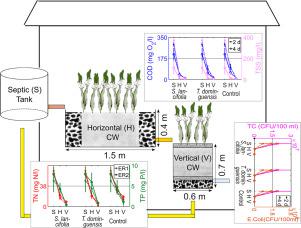Ecological Engineering ( IF 3.9 ) Pub Date : 2021-04-15 , DOI: 10.1016/j.ecoleng.2021.106243 M.I. Vega De Lille , M.A. Hernández Cardona , Y.A. Tzakum Xicum , G. Giácoman-Vallejos , C.A. Quintal-Franco

|
The objective of the present study was to evaluate the performance of a domestic wastewater treatment system based on hybrid constructed wetlands (CWs) under tropical climate. Moreover, the effect of different recirculation strategies particularly on nitrogen removal was also evaluated, including an analysis of nitrogen balance. The system was composed of a septic tank (pre-treatment), a horizontal subsurface flow and a vertical subsurface flow CWs. Three systems were analyzed: with the ornamental species Sagittaria lancifolia, the cattail Typha dominguensis and without vegetation as control. Evapotranspiration in the CWs was monitored during the warmest period of the year. First, the three systems were operated in serial mode evaluating two contact times of 2 d and 4 d. The three hybrid CWs were able to remove more than 92% of organic matter (COD, BOD5 and TOC), 88% of TSS and 99% (equivalent to 4.5 log10 units) of pathogens (Total Coliforms and Escherichia coli), regardless of plant selection and contact time. However, applying a contact time of 4 d resulted in higher removal of pathogens. Concerning nutrients removal, the combination of a contact time of 4 d and vegetation was required to achieve removal efficiencies over 66% for nitrogen and 90% for phosphorus. Finally, two recirculation strategies (RS) using a contact time of 4 d were evaluated in order to enhance nitrogen removal: RS1 (to the horizontal units) and RS2 (to the septic tank). The results yielded removal efficiencies similar to those obtained during serial operation in the case of organic matter (COD and BOD5) and phosphorus regardless of the RS applied. However, the removal of TSS decreased with RS2 as expected, due to the new load of solids coming from the septic tank. Nevertheless, nitrogen removal was increased over 85% in the hybrid CWs with vegetation, satisfactorily achieving system optimization. The highest nitrogen removal efficiency (≈ 97%) was obtained with the combination of RS2 and the plant species T. dominguensis. However, the use of the ornamental species S. lancifolia was not discarded since it provides an additional aesthetic benefit.
中文翻译:

热带气候下用于生活污水处理的混合人工湿地系统:再循环策略对脱氮的影响
本研究的目的是评估热带气候下基于混合人工湿地(CW)的生活污水处理系统的性能。此外,还评估了不同的再循环策略,特别是对脱氮的影响,包括对氮平衡的分析。该系统由化粪池(预处理),水平地下水流和垂直地下水流CW组成。分析了三种系统:观赏物种Sagittaria lancifolia,香蒲香蒲并且没有植被作为控制。在一年中最温暖的时期对连续水体的蒸散进行了监测。首先,三个系统以串行模式运行,评估两个接触时间2 d和4 d。三个杂种化工厂能够去除92%以上的有机物(COD,BOD 5和TOC),88%的TSS和99%(相当于4.5 log 10个单位)的病原体(大肠菌群和大肠杆菌)),无论工厂选择和联系时间如何。但是,施加4 d的接触时间会导致更高的病原体去除率。关于营养物的去除,需要4 d的接触时间和植被的接触,以使氮的去除效率超过66%,磷的去除效率超过90%。最后,评估了两种接触时间为4 d的再循环策略(RS),以提高脱氮效率:RS1(至水平装置)和RS2(至化粪池)。结果产生的去除效率与有机物(COD和BOD 5)连续运行时获得的去除效率相似。)和磷,而与适用的RS无关。但是,由于来自化粪池的新的固体负荷,TS2的去除率随RS2的降低而降低。尽管如此,在带植被的混合化CW中,氮的去除率增加了85%以上,令人满意地实现了系统优化。结合使用RS2和植物物种T. dominguensis可获得最高的脱氮效率(≈97%)。然而,没有放弃使用观赏物种兰芝(S. lancifolia),因为它提供了额外的美学优势。











































 京公网安备 11010802027423号
京公网安备 11010802027423号